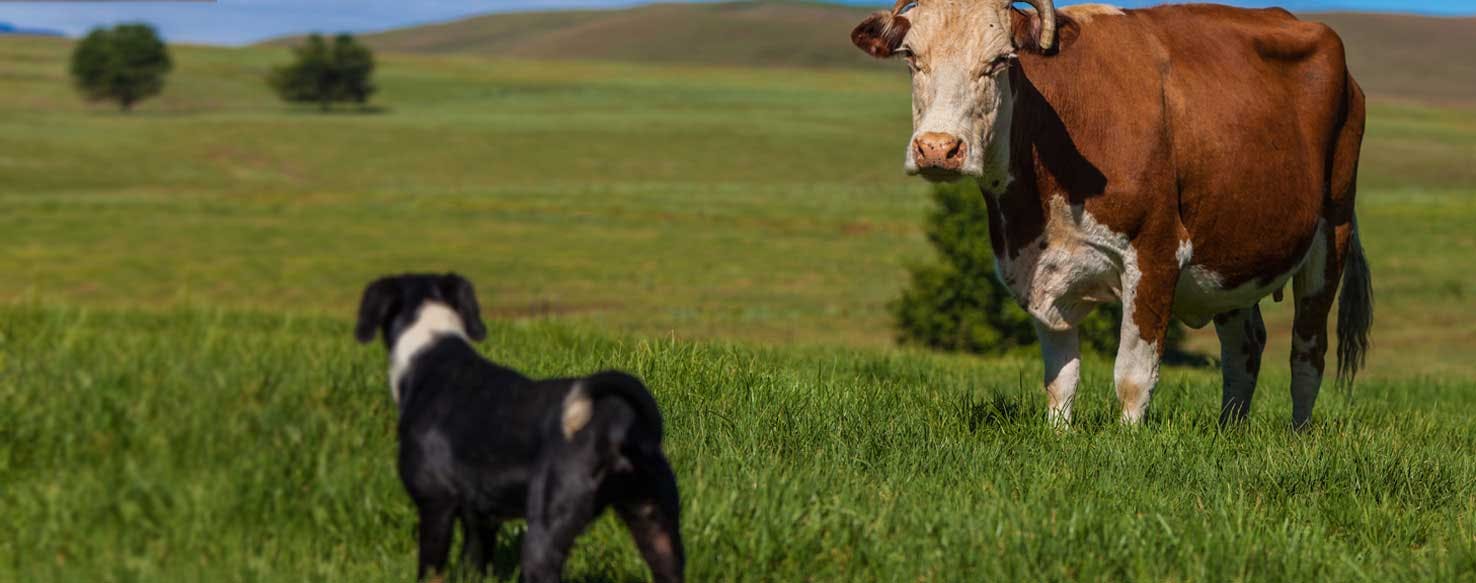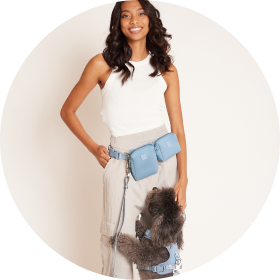- Home
- The Daily Wag!
- Senses
- Can Dogs Live With Cows?

We love our dogs as our best friends. On a farm, a dog is a tremendous helper to the farmer, guarding livestock, helping with herding the cows, and keeping company with both creature and human.
If you live on a farm with cows, you may discover that cows can be fun and affectionate, just like your dog. Cows can be playful, they like to be petted, they snuggle, learn tricks and give lickey face kisses!
But cows and dogs both have instinctive responses to stimuli and other animals. Cows are large, they can be aggressive, and they can make sudden reactions. Your dog is going to be smaller than the cows, making them more vulnerable to getting stomped. So what are things that you can do to help your creatures, great and small, to live together in harmony?
There are many stories about cows and dogs living together and getting along well with one another. You may want to watch both the cow and the dog for signs that things are going well in their relationship. Cows will lick animals they like. If you see your dog getting cow kisses, it's a positive relationship. You may also notice that your dog is playful and at ease around his cow friend. They may romp together in the pasture, snuggle for a nap, or just spend time side by side.
Your dog will show friendly behaviors if the relationship with the cow is going well. You may see your dog wagging his tail as a sign of his excitement. The dogs typically allowed around cows are known for being intelligent and attentive. Those attentive behaviors will be evident in your dog's movements, indicating he is aroused to watch and listen for commands from you and behaviors in the cows that are signals as to what he needs to do next.
Barking behaviors are your dog's ways of doing his job. If your dog has been trained to help you herd or guard the cows, when your dog is barking, he is giving you signals and telling the cows to "Move It". However, if your dog is not on the job and barking, this is a sign that he is stressed - and stressing the cows, so be aware of the time, place and activities that are associated with that barking behavior.
When dogs and cows are living together, they will each have areas where they sleep, eat, and exercise. While dogs and cows have different needs, you may find that a harmonious dog and cow relationship is one in which your dog has found some spots near the cow where he can be near his friend without getting hurt.
You may find that your dog is tuned into the schedule of milkings, feedings, grazing, and rest, and his energy level becomes aligned to the cow's activities of the day. But you will also need to be aware of your dog's basic instincts to be a predator, especially around calves. Watch for dropped ears, growling, staring or jumping behaviors that might signal that the calf is in trouble.
Body Language
Here are some signs you'll see when your dog is getting along with his bovine friends:
- Alert
- Barking
- Head Tilting
- Listening
- Wag Tail
- Raise Ears
Other Signs
Some other signs to watch for include:
- Seeking Closeness To Cow
- Following Cow Routines
- Playing Together
- Resting Together
It is believed that dogs were domesticated by man more than 15,000 years ago. Man and dog formed a relationship based on survival needs and hunting - the dog helping man to locate the kill and the man helping dog by sharing left-overs. Together they found protection and companionship.
Over time, the relationship between man and more species of animals also began to transform. Man's culture evolved from nomadic hunting to early forms of farming as gatherers learned to plant and grow food. With the settlement of man into communities, there were developments in how man harvested meat - by obtaining and raising their prey.
As civilization evolved into the formation of early farms, the role of dogs within these communities also changed. Dogs were now needed to help man with managing the livestock, herding and guarding this important food source from wolves and coyotes. The breeding of dogs capitalized on those skills and behaviors that made the dog most useful on the farm. Dogs have always played an important role in man's food system.
Dog breeds have evolved as jobs on the farm have also taken form. While most people think of herding dogs as most suitable to live among cows, it is important to consider the work the dog will be doing in relation to the dog. It is important to understand how the instincts of the dog to serve man.
If you intend to work the dog as a herding dog, it is wise to consider that the herding dog has been bred to regard livestock as prey. While the dog will not attack the cows, the dog is bunching and guiding the cattle in a form of hunting behavior. If it is your intention for the dog to guard the livestock, then you will want to select a smart breed of dog that is raised among the cows so that the animal comes to perceive the cows as members of his pack. The basic instincts of your dog may help to pre-determine the likelihood of the harmonious living relationship with cattle.
The livestock guardians who are most likely to attach to a cow as a pack member will be Anatolian Shepherd, Komondor, Maremma and Tibetan Mastiff. This is not to assume that your herding farm dog will not attach to your cows, especially when raised together. Always consider the disposition and training of the dog and the cow, as well.
There are biological reasons why dogs are adaptive to living on a farm. As dog has evolved to live with man and work on farms, so have the genomes of the dog. When the genomes of modern dogs are compared to DNA samples for archaeological discoveries of dog bones, they have established that today's dogs have more genomes that make the dog able to digest starch. The ability to consume starch is a marker that dogs evolved to live with others on farms.
When dogs are around dairy cows, there is a biological advantage to the development of the relationship between cow and dog. Oxytocin is a powerful hormone in milking mothers. It is known as the love hormone. It is likely that when your dog is near to cows when their oxytocin levels are elevated, the cow may be inclined to "love" your dog. The power of oxytocin in bonds is also observed when human mothers have a baby.
There are also behavioral explanations for domestic peace between cows and dogs. As the animals interact together under the supervision of the owner, recieving food, good rubs, and rewards, these positive experiences become associated with them being in the presence of one another. The positive relationship is essentially learned, under supervision.
Barns are not necessarily the safest places for dogs. Dogs are much smaller than cows. Cows can be unpredictable. It is easy for them to get stomped, kicked or injured if the cow reacts aggressively with them. Similarly, your dog can get excitable and irritate the cow by barking or activity that is stressful to the cow.
The best way to keep everyone calm and content in the same environment is to make sure your dog is well behaved and responsive to your commands. Start training your dog at a young age. Make sure your dog is secure in his basic commands before taking him into an environment with other, larger animals.
You will begin your introduction of the dog to the cow with your dog controlled on a leash and your cow also under control, being tied or in a stall. Let them get used to one another's smells. Gradually increase the time and proximity with one another.
The American Kennel Club has identified ten commands that every dog must know to stay safe in a barn or livestock environment. These commands are listed:
1. Come, even when there are distractions.
2. Stay, you need for the dog to stay put to allow you to work and to keep him at a safe distance.
3. Drop It, you need to keep your dog from carrying off something he should not have!
4. Leave It, teaches your dog to not bother something in the first place.
5. Down, this calm position is important to not agitate the cows
6. Go to Mat, teach your dog to know his spot to go sit to be safe
7. Sit, every good dog needs to sit on command
8. Leash Manners, help you to keep the dog under control and introduce your dog to environments
9. Crate, teach your dog to use his crate and be safe
10. Quiet, barking can irritate the cow and cause a harmful reaction
Good training always involves positive reinforcement with lots of praise and clear boundaries that keep the situation controlled for you, the dog and the cow.
Have questions or concerns about your pet?
Chat with a veterinary professional in the Wag! app 24/7.
Get Vet ChatKeeping Your Dog Safe Around Cows
- Do not leave your dog unsupervised around cows.
- Teach your dog to respond to your commands.
- Train your dog to sit and rest in a designated safe place or crate.
- Understand the disposition and dominance of the cow to prevent injuries to the dog.
Written by a Cavalier King Charles Spaniel lover Pat Drake
Veterinary reviewed by:
Published: 02/05/2018, edited: 04/06/2020
More articles by Pat Drake

